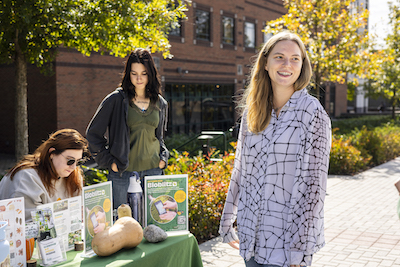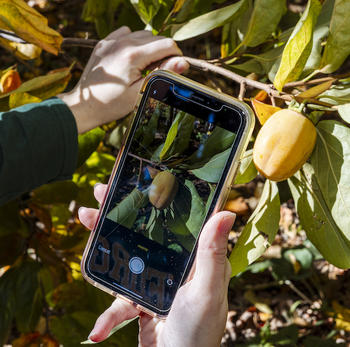George Mason University students are running around the campuses taking pictures of the flora, fauna, and fungi with their smartphones—sometimes in the dark—to capture the university’s biodiversity. They are trying to record as many species as possible with a focus on endangered species.

Photo by Cristian Torres/George Mason University
It is all part of Bioblitz 2023, which is an assessment project that began during Sustainability Month in October and continues through Nov. 19. For the project, Mason is using the iNaturalist app, which helps streamline the documenting process and even drops a pin of the discovery on a campus map.
So far, more than 800 observations have been made by 84 observers documenting 385 species. There are 155 “identifiers” in the app, subject matter experts and others who assist with confirming species identifications.
“What's great about the iNaturalist app is you post a photo, and it suggests identifications,” said Doni Nolan, Greenhouse and Gardens program manager in the University Sustainability office, who is leading the project. “Then [the app] also has folks confirm the identification to make it research-grade level.”
Bioblitz is another way Mason is using its campuses as a Living Lab. Working with Nolan are environmental and sustainability studies majors Eden Anderson and Sarah Jadlowski.

Anderson has used the app before. A huge fan of fungi, she first started capturing mushroom species on campus for an Environmental Science and Policy class, EVPP 408 Mushrooms, Molds, and Society, she took a few semesters ago.
“It’s been a really good mushroom season,” said Anderson, referring to some of the rain the area received in October. In the days after a rain, Anderson takes “mushroom walks” around the Fairfax Campus to see what fungi may have popped up.
“They can pop up quick, especially if it is humid,” said Anderson, who also forages mushrooms.
Anderson says the most unusual Bioblitz observation so far are jack-o-lantern mushrooms (omphalotus olearius), which are bioluminescent—with gills that glow green in the dark—and very poisonous.
Jadlowski is doing a moth survey of the Fairfax Campus as a project for her EVPP 480 Sustainability in Action class. She has attempted to lure moths out for a photo op in a variety of ways, including soaking a sheet in a diluted wine solution and hanging it near the Mason Pond with the hopes of capturing a moth “party.”
The survey is an attempt to see which parts of campus moths prefer with a longer-term goal—building a moth garden. But Jadlowski said campus bats will be the ultimate beneficiaries of any garden as they consume moths and other insects for their diets, and they are vulnerable pollinators.
Of 17 species of bats that have been recorded in Virginia, six are endangered, according to the Virginia Department of Wildlife Resources, with two of those species predicted to live in habitats near the Fairfax Campus. Protecting endangered species and their environments is a big part of the inventory. Nolan has made a list of Northern Virginia-specific endangered species they are keeping an eye out for, including the monarch butterfly.
The biodiversity assessment also ties into Mason’s Sustainability Tracking, Assessment, and Rating System (STARS) rating. In 2011, Mason began reporting its sustainability progress to the Association for the Advancement of Sustainability in Higher Education and earned a Silver rating. By 2014, Mason was the first university in Virginia to achieve a Gold STARS rating. Conducting the assessment helps Mason maintain its Gold rating and helps the university track the effectiveness of its sustainability efforts.
“We found monarch butterfly caterpillars on campus in several locations. Every year we have several patches in our gardens protected for them with the milkweed they prefer to eat,” said Nolan. “It was a focus [of Bioblitz] to identify endangered and vulnerable species and how the campus promotes those. So that was a big win for us.”
More Sustainability News
- April 26, 2024
- April 22, 2024
- April 19, 2024
- April 18, 2024
- April 16, 2024
